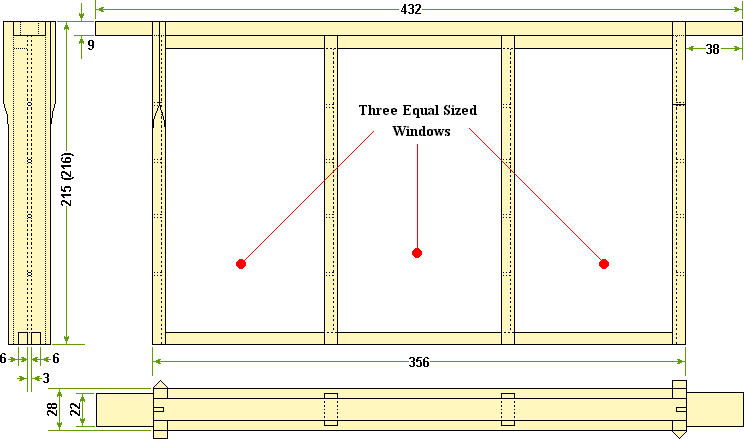Special and Unusual Frames
B.S. Frame Side bars
B.S. Bottom bars
Drone Culling
|
|
|---|
Three Panel Frame for Drone Culling
A simple three panelled frame to suit B.S. bee hives, which can be used to implement drone culling to aid varroa mite reduction.
|
Special and Unusual Frames B.S. Frame Side bars B.S. Bottom bars Drone Culling |
Three Panel Frame for Drone CullingA simple three panelled frame to suit B.S. bee hives, which can be used to implement drone culling to aid varroa mite reduction. |
|---|
British Standard Brood Size, but the principle can be extended to any size of bee hive frame by simple adjustment to suit the frame dimensions concerned.
|
Non Standard Components can be made from scratch or modified from existing pre-cut sidebars. Material... any timber that is to hand. Dimensions in mm. Scale = 1.5 pixels per mm. | 
|
|---|
|
The frame itself is nothing more than a standard brood frame with a couple of
extra struts so that the main area of the frame is divided into three equally sized panels.
I have taken the trouble to dimension the extra parts, but dimensions and quality of construction are not critical, however one thing that will help in making such frames is the use of solid bottom bars of 15 mm width. These may be found in some older types of frame or can easily be fabricated especially for the job, using dimensions from the bottom bars page. The red portions of the outlines show how the parts can be cut from the standard frame side that is illustrated in the top view of the group at right. The two alternative struts that are shown are suited to use with the commonly used 22 mm wide top bar, but if the Standard 28 top bar is used the version shown above left is more appropriate. The joint at the top of each extra strut is best made using small woodscrews, unless the wider 'bridled' form is used. Otherwise gimp pins can be used, as the frames are going to be handled and comb cut from then regularly, it may be wise to use adhesive on all joints to stiffen the finished frame. |

The illustration above shows 28 mm top bar and 22 mm struts in order to aid understanding. I would usually expect 28 mm struts to be used, but this is not critical.
Using standard frame parts to make the struts, means that there will be grooves and/or wiring holes, which will help to anchor the paneled combs and make it less likely that the comb will be completely sliced off when cut out of the panels. The remnants that are left give a guide for rebuilding and ensure that many bees can be involved in the re-building process which speeds up the process as it can start from several individual focus points.
The foundation retaining wedge bar can be cut to fit the panels and can be used to retain starter strips of drone foundation, in order to get the panels initially filled with drone cells.
Dave Cushman.
Page created 01/10/2005
Page updated 07/12/2022
Printed from Dave Cushman's website Live CD version
Written... 01 October 2005, Upgraded... 02 January 2008,
|